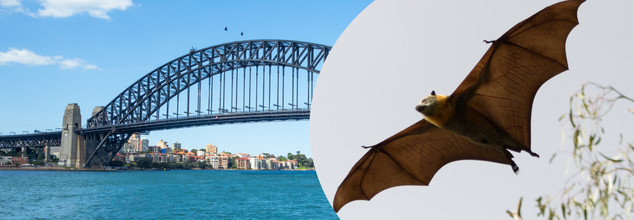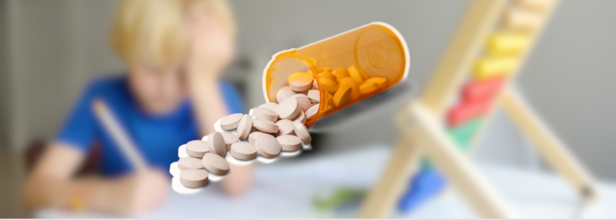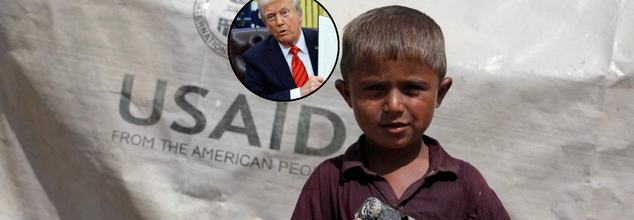- Health Conditions A-Z
- Health & Wellness
- Nutrition
- Fitness
- Health News
- Ayurveda
- Videos
- Medicine A-Z
- Parenting
- Web Stories
Australian Man Battles For Life After Rare 'Rabies-Like' Bat Bite; What Is The Deadly Lyssavirus

Credits: Canva
A man in his 50s from northern New South Wales, Australia, is fighting for his life in hospital after contracting Australian bat lyssavirus (ABLV), marking the state’s first ever confirmed human case. The incident, which has left health authorities and the public deeply concerned, highlights the persistent and often underestimated threat posed by zoonotic diseases—those transmitted from animals to humans.
The man was bitten by a bat several months ago and, despite seeking medical attention at the time, began displaying symptoms of lyssavirus only recently. He is now in critical condition, and health officials have confirmed that an investigation is underway to determine if other factors contributed to his infection.
The current case marks only the fourth confirmed human infection with ABLV in Australia. The previous three cases, all in Queensland between 1996 and 2012, resulted in fatalities. Each instance has reinforced the lethal nature of the virus and the critical importance of prevention and early intervention.
NSW Health and national health authorities have issued urgent reminders for the public to avoid handling bats under any circumstances. Only trained and vaccinated wildlife carers should attempt to rescue or manage bats in distress. Keira Glasgow, Director of Health Protection at NSW Health, emphasized, “The best thing you can do is to call your local wildlife carers agency to help you.”
Anyone exposed to a bat bite or scratch, regardless of vaccination status, should seek urgent medical care. Authorities stress that even minor contact can be dangerous, and any delay in seeking treatment increases the risk of fatal disease progression.
Bats are natural reservoirs for a range of viruses, including lyssaviruses and coronaviruses. Their unique immune systems allow them to harbor pathogens without succumbing to disease, but these viruses can be deadly when transmitted to other species, including humans.
In Australia, bats play essential ecological roles as pollinators and insect controllers, but their close proximity to urban areas and frequent human-wildlife interactions increase the risk of zoonotic spillover. This case underscores the importance of maintaining safe distances from wildlife and respecting the boundaries between human and animal habitats.
What is Lyssavirus?
Australian bat lyssavirus is a member of the Lyssavirus genus, within the same viral family as rabies. First identified in Australian flying foxes in 1996, its discovery shattered previous assumptions that Australia was free from rabies-like viruses. ABLV is genetically and clinically similar to rabies, causing severe neurological disease that is almost always fatal once symptoms appear.
The virus is found in various bat species across Australia, including fruit bats, flying foxes, and insect-eating microbats. Any bat in the country is considered a potential carrier, regardless of apparent health.
How the Virus Spreads?
Transmission occurs when the saliva of an infected bat enters the body through a bite, scratch, or contact with broken skin or mucous membranes (such as the eyes, nose, or mouth). Notably, even a minor scratch or seemingly insignificant contact can be enough to transmit the virus.
Bats carrying ABLV may not always show obvious signs of illness. However, infected bats can display unusual behaviors such as aggression, paralysis, inability to fly, or being found in atypical locations during the day. These signs should serve as warnings to the public to avoid contact and report such animals to wildlife authorities.
The incubation period for ABLV is highly variable, ranging from a few days to several years after exposure. This unpredictability makes monitoring and post-exposure management challenging.
Early symptoms mimic the flu:
- fever
- headache
- fatigue
- malaise
However, the disease progresses rapidly, with patients soon developing:
- Muscle weakness and sensory changes
- Confusion and agitation
- Convulsions and seizures
- Paralysis and loss of consciousness
Once neurological symptoms develop, the prognosis is grim. Death typically occurs within one to two weeks of symptom onset, and there have been no documented survivors of symptomatic ABLV infection in Australia to date.
Can Lyssavirus Be Treated?
There is currently no effective treatment for ABLV once symptoms have begun. The only hope for survival lies in immediate and appropriate post-exposure management. This includes:
- Wash the wound thoroughly with soap and water for at least 15 minutes.
- Use an antiviral antiseptic such as povidone-iodine or alcohol.
- Even if previously vaccinated against rabies, medical assessment is essential.
Medical professionals will assess the risk and may administer a combination of rabies immunoglobulin and rabies vaccine. If the exposure is on the head or neck, vaccination should occur within 48 hours. However, once symptoms develop, supportive care is the only option, and the outcome is almost invariably fatal.
While ABLV is currently confined to Australia, the broader lesson is universal. Zoonotic diseases—those that jump from animals to humans—are a growing global health concern, exacerbated by habitat encroachment, climate change, and increased human-wildlife contact.
How Can You Protect Yourself?
- Never attempt to handle bats or other wild animals. If you find an injured or distressed bat, contact trained wildlife carers.
- If bitten or scratched by a bat, immediately wash the wound, apply antiseptic, and seek urgent medical care—even if the injury seems minor.
- Vaccination is recommended for individuals at higher risk, such as wildlife carers and veterinarians.
- Educate children and communities about the risks associated with bats and the importance of reporting contact to adults and authorities.
Disclaimer: This article is for informational purposes only and does not substitute professional medical advice. Always consult healthcare professionals for diagnosis, treatment, or concerns regarding infectious diseases or bat exposure.
FDA Mandates ADHD Drug Labels To Warn Of Weight Loss Risk

Credits: Canva
The U.S. Food and Drug Administration (FDA) has announced a significant update to the labeling of all extended-release medications used to treat Attention-Deficit/Hyperactivity Disorder (ADHD). The change specifically targets the use of these drugs in children younger than six, warning about the risk of weight loss and other adverse reactions.
What Is ADHD?
ADHD is a common neurodevelopmental disorder that typically begins in childhood. It is characterized by symptoms such as inattention, hyperactivity, and impulsivity that can interfere with a child's development and daily functioning. Treatment usually involves a combination of behavioral therapy and medication, including stimulants like amphetamines and methylphenidate.
Labeling Change Reflects Off-Label Prescribing Trend
Although extended-release stimulants are not approved for use in children under six, the FDA notes that healthcare professionals sometimes prescribe them “off-label” to younger patients. This is typically done in cases where other treatments have failed or when symptoms are especially severe. However, the FDA warns that clinical trials have shown young children process these drugs differently from older children, often resulting in higher concentrations of the medication in the body.
These higher drug levels have been associated with an increased likelihood of side effects, including clinically significant weight loss. As a result, the FDA is requiring drug manufacturers to include a new “Limitation of Use” section in the prescribing information for all extended-release stimulant medications.
This section will outline the risks specific to children under six, including:
- Higher plasma concentrations of the drug
- Greater rates of side effects, including reduced appetite and weight loss
- The fact that extended-release formulations are not approved for this age group
Monitoring and Alternative Options Recommended
For young children already taking extended-release ADHD stimulants, the FDA advises healthcare providers to closely monitor the patient’s growth and development. Pediatricians should regularly chart weight and height to detect early signs of weight loss. If weight loss becomes a concern, alternative treatments should be considered.
These may include:
- Switching to immediate-release stimulants, which may be easier to manage in younger children
- Exploring non-medication interventions, such as behavioral therapies and parent training programs
- Reevaluating the overall treatment plan to ensure it aligns with the child’s developmental needs and physical health
What Should Parents and Caregivers Do?
Parents and caregivers are encouraged to stay alert for signs of weight loss in children taking extended-release stimulants. If any concerning changes in appetite or weight are noticed, it’s essential to consult the child’s pediatrician. The doctor can then weigh the benefits and potential harms of continuing the current medication and discuss safer alternatives if needed.
The FDA's move comes as part of its ongoing effort to improve pediatric medication safety and ensure that drug use in children is backed by evidence, especially when used outside of official guidelines.
Kate Middleton Opens Up About Her 'Really Difficult' Time During Chemotherapy And How Nature Helped Her Heal

Credits: Wikimedia Commons
Kate Middleton or Catherine, Princess of Wales reflected on the aftermath of chemotherapy in her first public appearance since she had unexpectedly withdrawn from Royal Ascot just two weeks ago.
She has called the entire experience "really difficult". On her visit to a wellbeing garden at Colchester Hospital in Essex, England on Wednesday, she told the patients, "You put on a sort of brave face, stoicism through treatment, treatment’s done – then it’s like ‘I can crack on, get back to normal.’ But actually the phase afterwards is really difficult, you’re not necessarily under the clinical team any longer, but you’re not able to function normally at home as you perhaps once used to."
The reason she visited the hospital garden in the Southeast of England was to "celebrate the incredible healing power of nature", noted Kensington Palace.
She also met with patients and hospital staff at the Cancer Wellbeing Centre "to understand how gardens in healthcare setting play a crucial role in promoting good health outcomes, preventing poor health and supporting increased recovery time."
Now 43, Kate herself has pointed out to the importance of nature in her health journey over the last year.
Is There Any Scientific Proof That Nature Could Actually Heal You?
Lisa A Cooper, MD, MPH writes in the 'Letter from the Director' at John Hopkins Medicine that nature does have healing power. She notes that green spaces play a role in cardiovascular health, and also facilitates to interact with other people who are there to enjoy nature. The American Psychological Association (APA) also noted that spending time in nature is linked to both cognitive benefits and improvements in mood, mental health and emotional well-being. The University of Cincinnati also points out that being out in nature can further reduce anxiety, lower blood pressure, enhance immune system function, and boost self esteem and mood.
In fact in a video, which was posted by Kate on X to mark Mental Health Awareness Week in May, she said, "over the past year, nature has been my sanctuary."
Kate's Cancer Timeline
In March, Princess Kate publicly shared her cancer diagnosis and confirmed she had begun chemotherapy. As she focused on her recovery, she stepped away from the public eye, making only a few limited appearances over the summer. By September, she announced she had completed chemotherapy and was "doing what I can to stay cancer-free."
Since then, the Princess of Wales has been gradually re-engaging with her royal responsibilities. While she has increased her public appearances this year, palace insiders say she is carefully managing her return to balance her health with her official duties.
Earlier this summer, Kate made high-profile appearances at key royal events, including the Trooping the Colour parade in London and the Order of the Garter service in Windsor. However, she later withdrew from the Royal Ascot at the last minute, signaling that her return to full-time royal duties is still being handled with care.
Just last week, Kate resumed in-person engagements, joining Prince William in hosting philanthropist Melinda French Gates at Windsor Castle. The meeting, reportedly focused on their shared philanthropic interests, marked one of her first official engagements in recent weeks.
On Wednesday, the Princess made a meaningful visit to Colchester Hospital, where she helped plant several “Catherine’s Rose” plants—a specially bred rose named in her honor by the Royal Horticultural Society. The visit coincided with the hospital receiving a donation of 50 such plants.
The rose holds special significance: proceeds from its commercial sale will go to The Royal Marsden Cancer Charity, supporting cancer patients through treatment and beyond. The funds will help the charity develop a dedicated program focused on improving quality of life for those living with cancer and those who have completed treatment.
Princess Kate has deepened her connection with the Royal Marsden since her diagnosis. In January, Kensington Palace announced she had been named joint patron of The Royal Marsden NHS Foundation Trust, the specialist cancer center in Chelsea, west London, where she received treatment.
Her involvement with the charity and efforts to raise awareness reflect her commitment to supporting others navigating a cancer diagnosis. While her return to public life is cautious and measured, each appearance signals both her resilience and her intention to use her platform for meaningful causes.
As she continues to recover and adjust, the Princess of Wales remains one of the most admired and closely followed members of the royal family—balancing personal healing with her public role.
Trump’s Foreign Aid Cuts May Lead To 14 Million Deaths By 2030, Lancet Study Warns

Credits: Reuters
The global community seems to have received a stark warning based a new study published in The Lancet, President Donald Trump's drastic cuts of US foreign humanitarian aid could lead to over 14 million extra deaths by 2030. The study, based on two decades of global health data, highlights the alarming consequences of retracting the US support to vulnerable groups, especially in low- and middle-income nations. With an estimated third of these deaths likely to be children, the results have left the global aid and public health communities in shock.
The Trump administration's wholesale slashing of foreign assistance programs was grounded in the "America First" doctrine, a political ideology that subordinates global involvement to domestic priorities. In March, US Secretary of State Marco Rubio said more than 80% of all USAID programs had been cut. The sudden rollback came as billionaire Elon Musk—then leading a federal workforce reduction effort—sought to re-make the delivery of aid programs, which critics claim were more concerned with trimming costs than with saving lives.
America has traditionally been the globe's biggest giver of humanitarian aid, with the US Agency for International Development (USAID) active in over 60 countries. In 2023 alone, America spent $68 billion on foreign aid. But in March this year, US Secretary of State Marco Rubio declared that the Trump administration had terminated more than 80% of all USAID programmes due to a desire to cut wasteful spending, as the administration claimed. It was an effort to cut the federal workforce and trim government operations, led in part by billionaire Elon Musk.
As per the Lancet research, written by Davide Rasella of the Barcelona Institute for Global Health and colleagues, the suggested 83% funding reduction has the potential to halt or even reverse two decades of improvement in global health. The researchers simulated the probable effect on low- and middle-income countries' mortality and opined that the end of U.S. support would unleash a devastating increase in avoidable deaths.
The team from The Lancet study examined data from 133 nations and projected the effect of the cuts over the period to 2030. Their forecasts are grim:
- Over 14 million extra deaths worldwide by 2030 if the cuts are not reversed.
- Over 4.5 million of those deaths would be children under the age of five, representing around 700,000 child deaths annually.
The impact on global health systems would be "comparable in magnitude to a global pandemic or a major war," co-author Davide Rasella of the Barcelona Institute for Global Health said.
The findings of the study are especially concerning for low- and middle-income countries, whose health, nutrition, and development programs have been a lifeline for USAID funding. The sudden cutoff in support risks stopping—and even reversing—two decades of advances in decreasing mortality and enhancing health outcomes among the world's most vulnerable citizens.
The United States' withdrawal has had spillovers. In Washington's wake, a number of other donor states, such as the UK, France, and Germany, also reduced their own contributions. The chain reaction has exacerbated the worldwide funding gap for humanitarian projects. The United Nations says that the global humanitarian community is now experiencing "the deepest funding cuts ever," as needs continue higher than ever in response to conflict, climate-related disaster, and pandemic fallout.
Between 2001 and 2021, estimated lives saved in developing countries through USAID-supported programmes are 91 million, including 30 million children. The effect was particularly significant among recipient countries with high volumes of aid, where all-cause mortality reduced by 15%, and child mortality declined by 32%. In focus disease areas, mortality due to HIV/AIDS, malaria, and neglected tropical diseases decreased by 74%, 53%, and 51% respectively in recipient countries with significant USAID presence.
The cuts now in place risk reversing these hard-won achievements. The authors of the study say the withdrawal of US funding will not only raise mortality but also destabilize health systems, undermine disease control, and deny millions access to life-saving services
Ironically, the release of the Lancet report happened at the same time that a large United Nations-sponsored aid conference took place in Seville, Spain—the largest one in a decade. The lack of U.S. participation in this pivotal meeting did not escape attention. Critics point out that Washington's absence belittles decades of American dominance in global health diplomacy and squanders its credibility as a humanitarian leader.
President Trump has consistently justified the cuts as a way to eliminate waste and make sure US spending is aligned with America's national interests. Secretary of State Rubio said the remaining 1,000 or so aid programs will be handled "more effectively" by the State Department and in coordination with Congress. Critics counter that the cuts are short-sighted and could jeopardize both global stability and America's international reputation.
Human rights activists and world health professionals warn that the erosion of US leadership in humanitarian assistance could spur other nations to do the same, further exacerbating the crisis. The authors of the Lancet study emphasize that if the sudden funding reductions are not reversed, the world will see a "staggering number of avoidable deaths" in coming years
They also support more intelligent, effective aid delivery systems that focus on transparency, local participation, and evidence-based action. The bottom line: investing in global health is not only a moral imperative but a strategic one that ensures world stability, economic growth, and public health security.
With the world confronting increasing challenges—from climate change and pandemics to conflict and displacement—the demand for strong, united global assistance has never been greater. The future of millions of people is at stake, and the choices that are made today will determine the future of global health for generations to come.
© 2024 Bennett, Coleman & Company Limited

